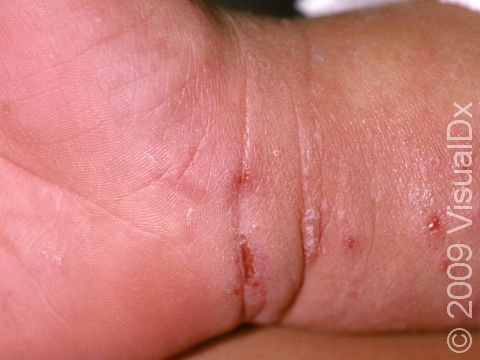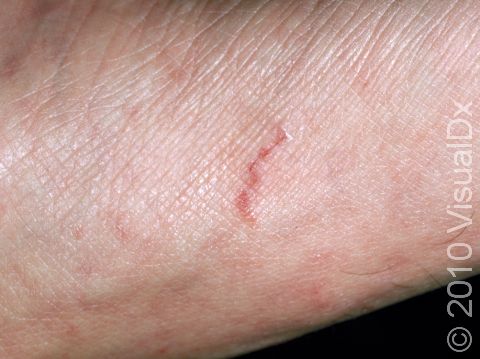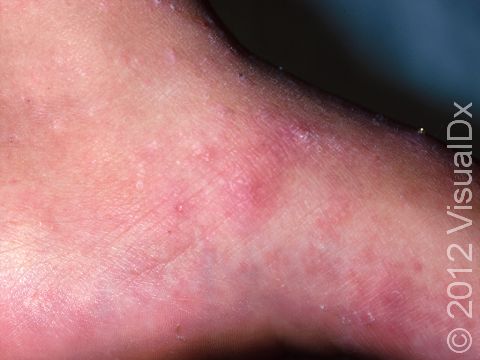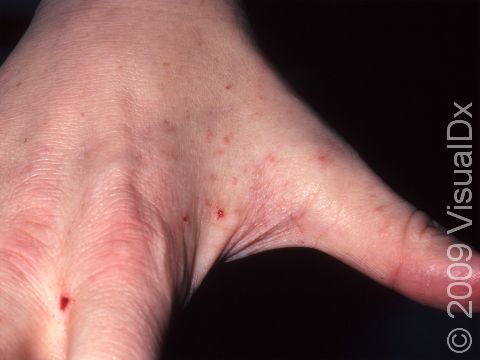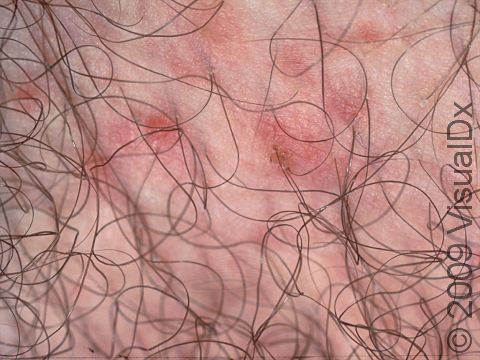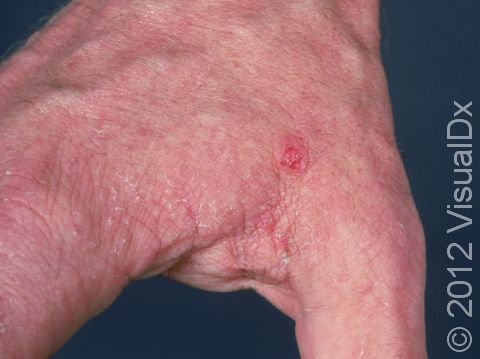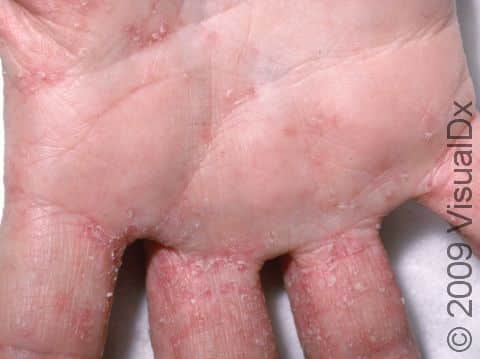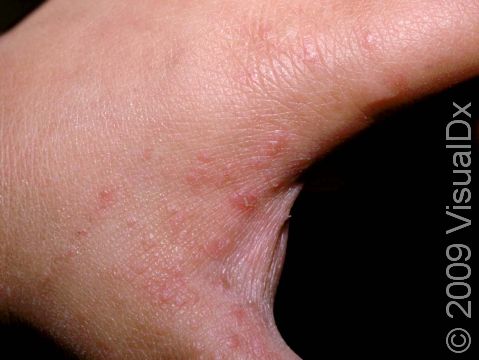Scabies
Scabies is a very itchy, contagious rash caused by tiny mites that infest the skin. The mite (called Sarcoptes scabiei) lives on the skin and tunnels under the skin in straight or wavy fashion, causing the characteristic rash: general redness and itchiness with some raised pink straight or wavy lines. The rash is usually most obvious in the spaces between the fingers and in body creases such as the armpits, groin, breasts, and elbows. The itchiness can be intense and is often worse at night. The mites are passed by skin-to-skin contact and also by sharing intimate objects such as towels, sheets, and mattresses. The skin-to-skin contact needs to be prolonged, so a hug or a handshake will likely not transmit the mites. Even though mites can infect the groin, scabies is not considered a sexually transmitted disease.
The first time a person is exposed to mites, it may take weeks for the itchy rash to develop; on subsequent exposure(s) to mites, the itchy rash will likely develop within days.
Who's At Risk?
Most cases of scabies are transmitted in crowded areas such as hospitals, nursing homes, homeless shelters, day-care centers, and within families, although anyone at any age can get scabies if exposed to the mite.
Signs & Symptoms
Although the entire body may itch, the most common locations for the lesions of scabies include:
- The areas between the fingers (finger webs)
- Inner wrists, inner elbows, and armpits
- Breasts of females and genitalia of males
- Navel (umbilicus)
- Lower abdomen
- Buttocks
- Backs of knees
The most obvious signs of scabies are pink-to-red bumps, which can look like pimples or bug bites. However, the tell-tale lesion of scabies is the burrow, which is small, subtle, and difficult to detect. Typically, a burrow appears as a fine, thread-like, scaly line (3–10 mm long), sometimes with a tiny black speck (the burrowing mite) at one end.
Scabies is intensely itchy, especially at night.
Scratching the itchy lesions can create breaks in the skin, and these breaks can become infected with bacteria.
A severe form of scabies, called Norwegian scabies or crusted scabies, is seen in:
- Elderly people
- Individuals with weakened immune systems (such as organ transplant recipients or people with HIV/AIDS)
- Malnourished people
- People who are physically and/or mentally impaired or disabled
In people with Norwegian/crusted scabies, the skin is covered with thick, white scales and crusts. The lesions are extensive and widespread, appearing over the scalp, face, elbows, knees, palms, and soles of the feet. The mite population can soar to hundreds, thousands, or even millions.
People who are exposed to scabies may not develop itchy lesions for up to 6 weeks after becoming infested, as the immune system takes some time to recognize the mites and develop an allergic response to them. However, individuals who have had scabies before may develop the rash within several days of re-exposure.
Self-Care Guidelines
Though scabies is extremely contagious, it usually requires prolonged skin-to-skin contact with a person already infested. A quick handshake or hug will not normally spread the infection. However, scabies is easily spread to sexual partners and to other members of a household. Less commonly, it may be spread by sharing towels, clothing, or bedding.
Scabies requires prescription medication in order to stop the infestation. Once you are under a doctor’s care, there are steps you can take to prevent scabies from coming back:
- Mites cannot survive off the human body for more than 48–72 hours. Therefore, wash all clothing, bedding, and towels used by the infested person in approximately the previous 72 hours in hot water and dry these items in a hot dryer.
- Vacuum all carpets, rugs, and upholstered furniture, and discard the vacuum bags.
- Anything that cannot be laundered should be sealed in plastic bags for 5 days.
Treatments
Your physician may be able to diagnose scabies simply by examining your skin for typical lesions, such as burrows. A skin scraping, called a scabies preparation, may be examined under a microscope for mites, eggs, or mite droppings (feces).
In most cases of scabies, your doctor may recommend a topical cream or lotion, such as:
- Permethrin cream – After application, wash the cream off after 8–14 hours. Use the permethrin cream again in one week.
- Crotamiton lotion or cream – Apply once daily for 5 consecutive days.
- Sulfur ointment – Apply nightly for 3 consecutive nights. This is often the best choice for babies and for pregnant and nursing women because it is very safe to use.
- Lindane lotion or cream – Wash the cream or lotion off after 8 hours. Lindane may be toxic to some people. Therefore, young children and infants, pregnant or breast-feeding women, and people with diseases affecting the nerves (neurological diseases) should not use lindane.
When using a topical cream, lotion, or ointment, be sure to follow these steps (unless your physician gives other instructions):
- Apply to the entire body.
- Smear the product beneath the fingernails and toenails.
- Apply to body folds, including inside the navel, in the buttock crease, and between the fingers and toes.
In more severe cases of scabies, your doctor may prescribe oral medications:
- Ivermectin pills – Take once and then repeat 1–2 weeks later; not for use in pregnant or lactating women or in children under the age of 5
- Antihistamine pills
- Antibiotic pills, if any scratched areas appear to be infected with bacteria
Itching may take up to 3 weeks to go away as your immune system continues to react to dead mites. However, new burrows and rashes should stop appearing 48 hours after effective treatment.
Your doctor should remind you to launder towels, bed linens, and clothes used in the previous 72 hours and to vacuum carpets, rugs, and upholstered furniture.
Household members, sexual partners, and anyone else with prolonged skin-to-skin contact with an infested person should also seek treatment from their doctor. Because the initial development (incubation time) for scabies infestations can be from 6–8 weeks, people may be infected with scabies, but because they do not yet feel itchy, they are unaware that they have an infestation. If untreated, these close contacts could pass the mites back to you. Ideally, everyone should be treated at the same time in order to prevent re-infestation.
Visit Urgency
See your doctor for evaluation if you develop an extremely itchy rash that does not go away. Because it may take weeks for the rash to develop, if one person in a household has scabies, the whole family should be treated, and all towels and bed linens should be run through a hot dryer to kill the mites and eggs. If other close contacts have similar itchy rashes, make sure they are also evaluated by a physician.
References
ed. Dermatology, pp.1321-1324. New York: Mosby, 2003.
Freedberg, Irwin M., ed. Fitzpatrick’s Dermatology in General Medicine. 6th ed. pp.1374, 1394, 2283-2284. New York: McGraw-Hill, 2003.
Last modified on August 16th, 2022 at 2:44 pm

Not sure what to look for?
Try our new Rash and Skin Condition Finder
